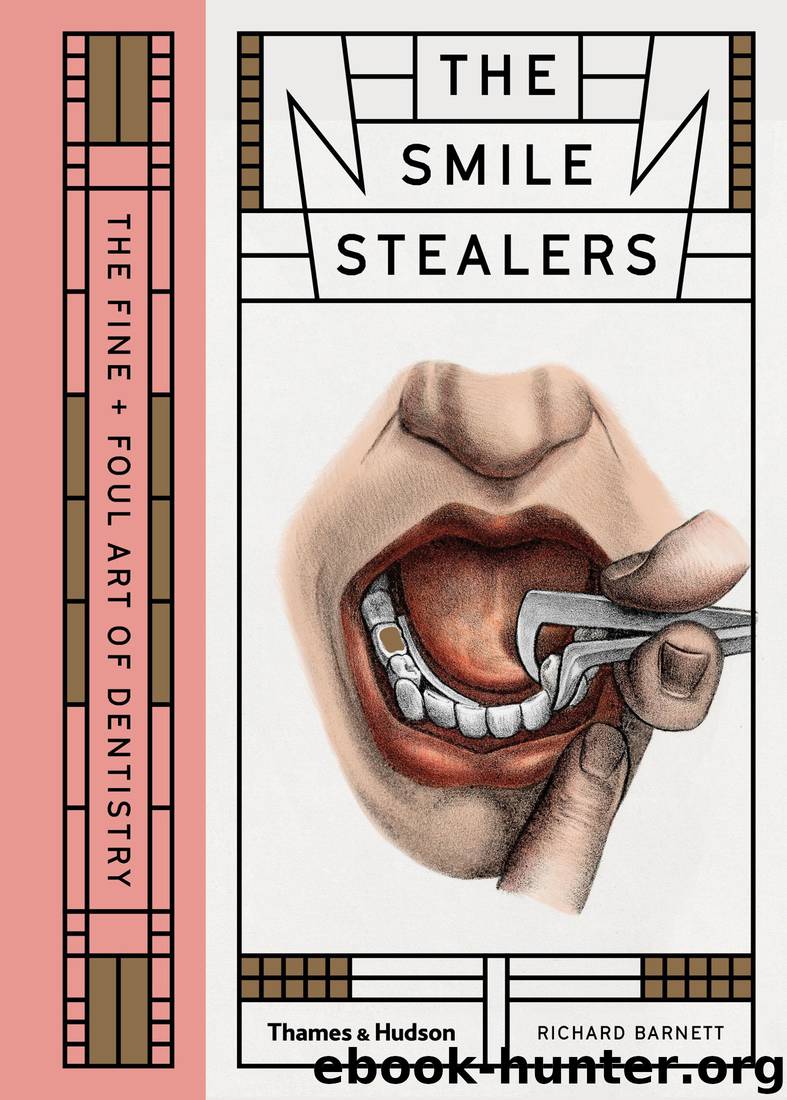The Smile Stealers: The Fine and Foul Art of Dentistry by Richard Barnett

Author:Richard Barnett [Barnett, Richard]
Language: eng
Format: azw3
Publisher: Thames and Hudson Ltd
Published: 2017-04-27T04:00:00+00:00
THE FLOOR, HE WENT FOR WELLS, BENT ON REVENgE FOR THE HOAX THAT HAD BEEN PLAYED ON HIM. AND THE AUDIENCE FOLLOWED SUIT. ‘HUMBUg, SWINDLE,’ THEY SHOUTED, ‘THROW HIM OUT. THIS IS A UNIVERSITY AND NOT A CIRCUS.’ This episode – which effectively ended Wells’ career as a dentist – illustrates the main difficulty facing all early experiments with nitrous oxide. The success of the frolics had been built on the unpredictable and raucous effects of laughinggas in those who breathed it, and this made dosage extremely hard to estimate – particularly when the gas was administered from a large rubber bag. The major breakthrough in dental anaesthesia came when Morton began to experiment with a different substance. In 1844 he had attended lectures given by the physician Charles Thomas Jackson at Harvard Medical School. Jackson had demonstrated the power of ether to cause unconsciousness and was also in the habit of using drops of ether to numb the pain of toothache. Borrowing this idea, Morton convinced one of his patients, Eban Frost, that ether was a better bet than mesmerism for a painless extraction. On the evening of 30 September 1846, Morton asked Frost to breathe ether vapour from a silk handkerchief. In a testimonial, the patient recalled that after a minute or so he was ‘lost in sleep’, but ‘in an instant more I woke and saw my tooth lying on the floor. I did not experience the slightest pain whatsoever.’ Morton moved quickly to secure his claim to the proceeds from ether anaesthesia. He and Jackson filed a patent, and he entered a lucrative new partnership with the dentist Nathan Cooley Keep, offering painless extractions to the people of Boston. By the end of the year, Morton had received his patent, and news of his discovery rang around the world. In London the American physician Francis Boott received a letter from a friend, Jacob Bigelow, who had witnessed Morton’s demonstration. Boott passed the description to his neighbour, society dentist James Robinson, and on 19 December Robinson carried out the first British general anaesthetic, pulling a decayed molar from the jaw of one Miss Lonsdale. Although Morton was successful in obtaining credit for the discovery of ether, his attempt to make a fortune from it proved fruitless. Many surgeons opposed his patent, arguing that they should be ① Portrait of Joseph Clover preparing his chloroform inhaler (c. 1862). ② An early inhaler for ether anaesthesia (1847–48). Ether-soaked sponges were placed in the glass jar and flexible tubing connected the valve to the face mask so the patient could inhale the gas. ③ One of the first operations to use ether as an anaesthetic agent, performed at the Massachussetts general Hospital. Daguerrotype (1897). Smile_Stealers_pp1-247.indd 162 24/11/2016 18:0
Download
This site does not store any files on its server. We only index and link to content provided by other sites. Please contact the content providers to delete copyright contents if any and email us, we'll remove relevant links or contents immediately.
| Administration & Medicine Economics | Allied Health Professions |
| Basic Sciences | Dentistry |
| History | Medical Informatics |
| Medicine | Nursing |
| Pharmacology | Psychology |
| Research | Veterinary Medicine |
Essentials of Biostatistics in Public Health by Sullivan & Sullivan(1364)
Critical Thinking: Understanding and Evaluating Dental Research by Donald Maxwell Brunette(1315)
The Dental Diet by Steven Lin(1183)
One of the Guys by A.R. Perry(1171)
Basic Biostatistics by B. Burt Gerstman(1165)
Tooth Whitening Techniques by Linda Greenwall(1135)
0263927350 by A. L. Bird(1087)
ACT Prep 2019 by Kaplan Test Prep(1075)
Cure Tooth Decay: Heal And Prevent Cavities With Nutrition - Limit And Avoid Dental Surgery and Fluoride [Second Edition] 5 Stars by Nagel Ramiel(1066)
46 Where There Is No Dentist by Where There Is No Dentist(1050)
Dental Practice: Get in the Game by Michael Okuji(1036)
Essential Dental Therapeutics by David Wray(1024)
Small Animal Dentistry by Heidi B. Lobprise(1013)
Bone Biology, Harvesting, Grafting For Dental Implants by Arun K. Garg(993)
Dental Caries by Zhou Xuedong(984)
Dentistry with a Vision: Building a Rewarding Practice and a Balanced Life by Gerald I. Kendall Gary S. Wadhwa(981)
A Textbook of Dental Homoeopathy by Dr Colin B. Lessell(980)
Fundamentals of Operative Dentistry by James B. Summitt(979)
Uncomplicate Business: All It Takes Is People, Time, and Money by Howard Farran(927)
